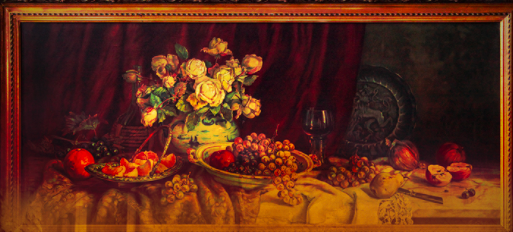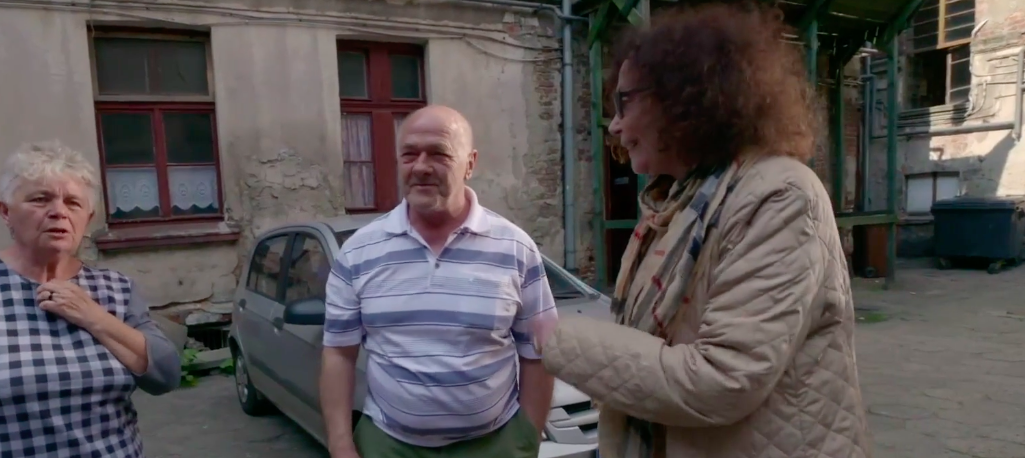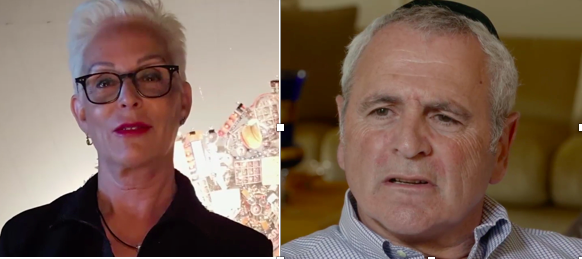“Still Life in Lodz” Asks If Jewish Life in Lodz Is Still Possible or Does It Lie Only in Memory
By Sue Weston and Susie Rosenbluth – Two Sues on the Aisle
Those looking to reconnect with their past know that almost anything can serve as a trigger, that jolt of energy that says contact has been made. In the documentary, “Still Life in Lodz,” filmmaker Slawomir Grünberg presents three Jews with very different stories as they explore the possibility of finding the past through their families’ connection with the Polish city of Lodz, which, before World War Two, boasted a Jewish population of more than a quarter of a million.
The narrator and guide in this film, which opens in virtual cinemas nationwide beginning March 12, is Lilka Elbaum, a Lodz native, born after the war when her survivor parents, looking for a place to live, were guided to Lodz, which was still home to about 50,000 Jews.
When we meet Ms. Elbaum, she is returning to Lodz 48 years after post-Six-Day-War antisemitism in 1968 forced her family, like virtually all of Poland’s remaining Jews, to flee. Her family left for the United States.
Her visit to the city, home now to only a few hundred Jews, is bittersweet, and she uses the memory of her family’s apartment, especially a still-life painting which hung over her childhood bed while she lived there from 1945 to 1968, as the hook for her recollections.

Still life painting from Ms. Elbaum’s apartment in Lodz
The history of this painting, its owners changing according to the politics and murderous rampages of people far removed from the apartment in which it was housed, mirrors the community and the continuity of its inhabitants. The still-life is the powerful silent witness to disruption and genocide, exile and longing.
More Than 70 Years
In fact, Ms. Elbaum learns that the painting had been in the apartment, in the very same spot, well before the war, probably since the building was first inhabited in the late 1890s. Before the Nazis invaded, the apartment was the home of a Jewish woman dentist, who lived there with her young sons. During the war, after the Jews had been removed by the Nazis, the apartment—and the painting—fell into the possession of a Polish carpenter who identified as a Volksdeutsche, an ethnic German whose language and culture had German origins but who did not hold German citizenship. The Nazis’ goal was to grant German citizenship to all Volksdeutsche and elevate them to positions of power over the native populations.
After the war, the Polish carpenter fled, leaving the apartment vacant and the painting still on the wall, where it became the focal point of Ms. Elbaum’s memory of Lodz, the first thing she saw in the morning, the last thing at night.
At the start of the film, Ms. Elbaum, now living in Boston, finds the apartment, but the spot where the painting had been is empty. She has no trouble finding it in its new location, a Polish family’s country house, but her investigation into the city of her birth and its troubled history, still tinged with antisemitism, is just beginning.
Ms. Elbaum’s interactions with the painting are captured through the clever use of animation, but her exchanges with former neighbors and other residents of Lodz make up the heart of the film. The message is that history, left ignored, can obstruct healing, while acknowledging what happened and recognizing the causes can serve to build bridges to move past the hate. Perhaps by documenting the past, people can create safe and inclusive futures.

Ms. Elbaum with neighbors from her building
Two Other Stories
While Ms. Elbaum’s story exposes her personal sadness at being forced to leave the home of her birth and childhood, her return to the very familiar city allows her to act as a guide to two other Jews with very different ties to the city.
Roni (Halpern) Ben-Ari, an Israeli photographer, visits Lodz with Ms. Elbaum in order to see the apartment where her father was born. Her father, who left Poland in the 1920s, had in his possession a menorah that had been given to him by his father. If the still-life painting is Ms. Elbaum’s artifact from Lodz, the menorah is Ms. Ben-Ari’s tactile connection.
Paul Celler, a New Jersey-based second-generation Holocaust survivor, has no objective relic tying his past to Lodz. He has his mother’s entire pre-war life. His visit to Lodz is based on his need to search for links to his mother’s life before she was taken from Lodz on the last transport from the ghetto to Auschwitz.

Roni (Halpern) Ben-Ari and Paul Celler
Seeking Closure
Through family stories, he knows of his mother’s disappointment in her Polish-Gentile neighbors, whom she had always thought of as friends when they cheered while Jewish women were humiliated by being forced to scrub streets. He knows that his mother’s youngest sister, only 15 when she was taken by the Nazis to Auschwitz, was summarily shot in cold blood when she tried to insist that she was able to work.
With Ms. Elbaum as a guide, he is able to visit an important town square his mother had remembered for its water pump. Polish residents report that the entire square has been rebuilt since the war. Only the non-working pump remains, mostly hidden from view. With no memorial erected to the tragic deaths this artifact has witnessed, Mr. Celler recites Kaddish for the thousands who perished.
Although the film does not make it clear, it is possible that the pump serves the same transcendent purpose for Mr. Celler that the painting and menorah do for Ms. Elbaum and Ms. Ben-Ari.
A Second Expulsion
Throughout the film, Ms. Elbaum interviews modern-day Polish residents of Lodz, many of them old enough to remember the Holocaust and the subsequent antisemitism. While those who appear on camera are pleasant enough, the ubiquitous casualness with which they recall her family’s need to leave is inescapable.
When she introduces people who still live in the building and remember her as a child after the war, they tell her, “When you moved out, other people moved in,” as though the family had simply opted to relocate. They express no regret about the rampant, government-inspired antisemitism that forced her parents to leave.
It was, in effect, an expulsion, a fact of history that is rarely discussed. The usual assumption is that Jewish life in Poland ended with the Holocaust. In fact, it ended in 1968.
The local synagogue where, even after the war, overflowing crowds turned up to pray, now attracts barely a minyan, and it is not unusual for local thugs to do whatever they can, short of violence, to disrupt services. When Ms. Elbaum complains about the situation to a neighbor, he comments, “These are different times.”
Holocaust Ties
While Ms. Elbaum’s personal knowledge of Lodz is not Holocaust-based, her family’s history is. In the film, she visits the farm where her mother was hidden by a stranger who took pity on her and risked his and his family’s lives to save hers. Perhaps one of the film’s most moving moments is the image of Ms. Elbaum playing with the infant great-granddaughter of her mother’s rescuer.
The Holocaust hangs over all three of the film’s Jewish seekers. How could it not? Despite its vigorous pre-war Jewish history, Lodz is most commonly associated with the ghetto established by the Nazis. With nearly 200,000 Jews driven into an overcrowded 1.5 square-mile area, the Lodz Ghetto was the second-largest after the one in Warsaw and the last to be liquidated. In 1944, its remaining population was transported to the Auschwitz and Chelmno extermination camps, where most were murdered upon arrival.
Mr. Celler correctly recognizes his mother’s survival—which, by extension, means his own—as a miracle.
The Real Heroes
Ms. Elbaum’s memories and the attitudes of many modern-day Poles can serve as powerful reminders of how important it is to be aware that shifts in sentiment can turn in an instant. Neither slogans, such as “Never Again” and “Never Forget,” nor victim-centered Holocaust memories offer protection. Ms. Elbaum and Mr. Celler are the lucky beneficiaries of their parents’ good fortune to survive. Ms. Ben-Ari’s father had the prescience to get out before he had to become a survivor.
Ms. Elbaum’s still-life painting, a silent witness to the tragic history of Lodz’s Jews, serves as a metaphor for her search to document her memories. The film might have had a more cohesive thread if, instead of Mr. Celler and Ms. Ben-Ari, the other seekers had had personal, rather than once-removed, memories that were also associated with artifacts from Lodz.
The rescuers of Ms. Elbaum’s mother deserve one more note. Some historians and psychologists—to say nothing of philosophers—have insisted that we pay too much attention to those Gentiles who either tried to ignore the evil swirling around them during the Holocaust or, worse, actively participated in it. Perhaps the important subjects of our investigations should be the people who knew the consequences of risks in helping others and took them anyway. It would have been helpful if Ms. Elbaum had spent more time exploring the motivations and thoughts behind the actions of her mother’s rescuers. If only we could teach the kind of impetus it takes to create people like that.
***
Two Sues on the Aisle bases its ratings on how many challahs it pays to buy (rather than make) in order to see the play, show, film, or exhibit being reviewed.
“Still Life in Lodz” received 3 challahs.

Three Challah Rating





